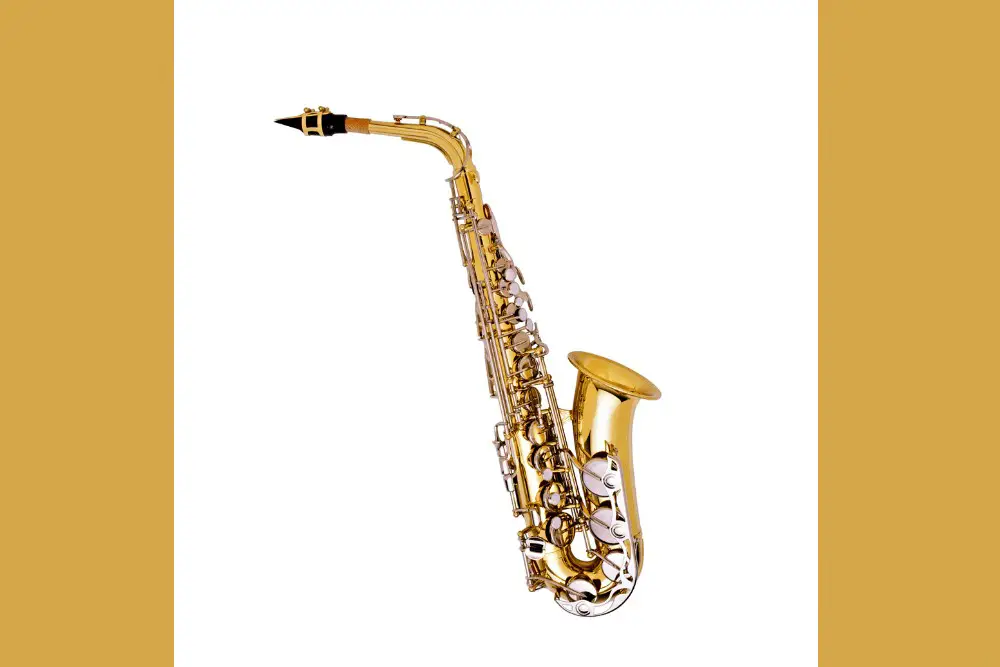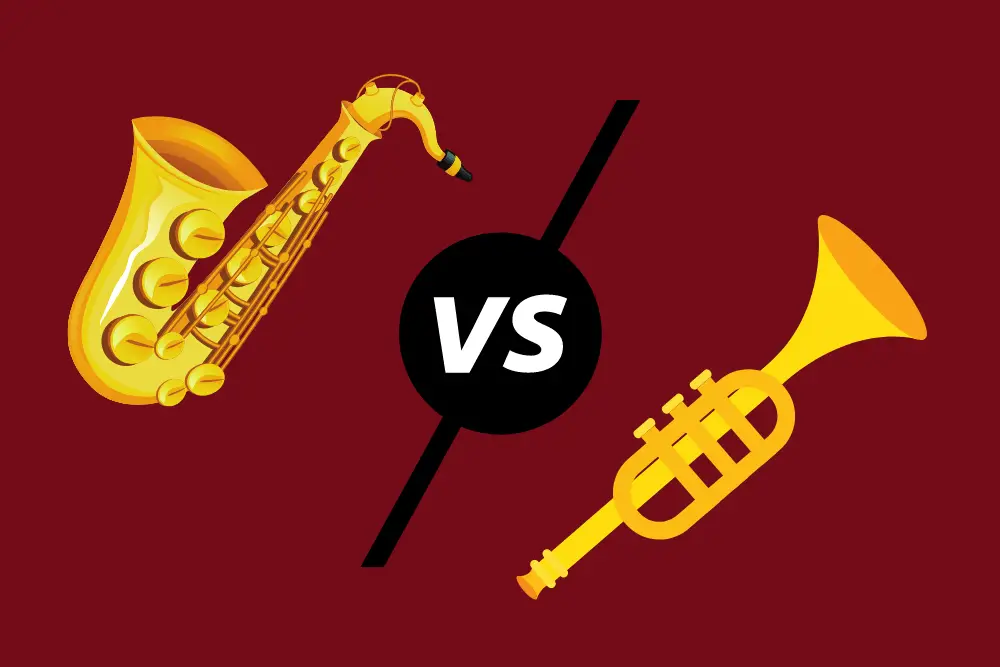The saxophone and the trumpet are two of the most popular band instruments. As a music teacher, I’m asked all the time by students, parents, and interested musicians what the differences are between them and which is the best to play.
There are many differences and similarities between the saxophone and the trumpet. Both are wind instruments (called aerophones) and are commonly found in bands and jazz. However, the alto saxophone is a woodwind instrument, larger, and lower-pitched while the trumpet is a brass instrument, shorter and higher-pitched. Both are equally easy to play for beginners.
This is, of course, a brief rundown of the two. Let’s dig into the details below.
Table of Contents
Saxophone Vs. Trumpet Direct Comparison
| Quality | Alto Saxophone | Trumpet |
|---|---|---|
| Instrument Family | Woodwind Family | Brass Famly |
| Sound creation | Vibrating reed on the saxophone mouthpiece | Buzzing lips into the trumpet mouthpiece |
| Where is it found? | Band, Jazz, Saxophone quartets, Popular music | Everywhere but most commonly: Band, Jazz, Orchestra, Brass Bands, Brass Quintets |
| Voice (Range) | Alto (Db3-Ab5) | Soprano (E3-Bb6+) |
| Number of Keys | Around 20 | 3 |
| Length Of Tubing | 3.9 ft (1.2 m) | 4 ft 10 in (1.48 m) |
| Average Cost For Intermediate Level Instrument* | $5,000 | $3,000 |
| Typical Role in Ensembles | Harmony, occasional melody | Melody or ornamentation |
| Other types of | Soprano, Alto, Tenor, Baritone | Trumpet in Bb, C, Cornet, Flugel Horn |
| When was it invented? | 1840s | 1400s, rose in popularity in the 1600s |
| General sound description | Round, deep | Rich, shiny, mellow |
| How To Change Pitch | Pressing keys covers and uncovers the tone holes changing the vibration frequency (Hz) | A combination of valves changing the length of the tubing and tightening and loosening the lips as they buzz |
| Material | Typically brass with a lacquer protection | Typically brass with a lacquer protection |
Note: The basic measurements and range are based on the alto saxophone, which the typical starting type of saxophone and most common size played.
*Based on the average of select products recommended by numerous band teachers and music educators.
What’s The Difference Between Saxophone And Trumpet?
The easiest place to start is with the differences between these two musical instruments. Let’s dig in.
Looks
First, they don’t look a lot alike.

The saxophone has a mouthpiece with a wooden reed on it which sits on the mouthpiece. (Learn how to clean a saxophone mouthpiece with our guide.)
It’s held on by a screw mechanism called a ligature.
The mouthpiece goes on the cork of the neck (click to learn how to replace neck cork), which is a crook shape. Then it inserts into the body of the sax.
Except for the soprano saxophone, the sax body is a straight tube with an elbow on the end, bringing the bell back up and forward. The body is covered in tone holes, which are, in turn, covered by pads attached to rods attached to keys which, when pressed, change the notes.

The trumpet appears smaller, though it’s longer. It uses a (typically) metal mouthpiece which is a small cup shape.
The mouthpiece fits into the receiver of the trumpet. From there, the tube of the trumpet wraps in an oblong oval once before flaring out into the iconic bell shape.
The trumpet features a few small slides for adjusting the pitches of the valves and overall trumpet. There are three buttons (called valves) which add length to the tubing when pressed and help change the note.
Sound Production/Instrument Family
Specific families are determined by how an instrument produces its sound. All sounds need vibration to create the soundwaves in the air.
With the saxophone, the vibration comes when you blow on the reed on the mouthpiece. This starts the vibrations, which are transformed and amplified by the body of the saxophone.
Its status as a reed instrument makes the saxophone a member of the woodwind family. I’ve seen people who claim to understand music mislabel the sax as a brass instrument because its body is made of brass.
The key to sorting families is in how they produce sound.
The trumpet makes its vibration through the buzzing of lips into a mouthpiece. Then, the sound waves are transformed and amplified through the tubing of the trumpet.
The buzzing lips are the defining feature of the brass family, which is why the trumpet is in this family. The name is kind of confusing for many people. Brass instruments are usually made of brass, but they may be made out of anything as long as they use buzzing lips to make a sound.
Size/Range Of The Saxophone And Trumpet
Going off the alto sax size, these two instruments vary in size and range. (Learn more about the lowest note on the alto sax.)
The alto saxophone has 3.9 ft (1.2 m) of tubing and a range of Db3-Ab5 (sounding pitch).
The trumpet has 4 ft 10 in (1.48 m) of potential tubing (when all valves are pressed). This gives it a range of E3-Bb6 (sounding pitch).
Of the two, the trumpet has a greater range potential. Although, through the use of the altissimo technique (an expert-level one), the alto saxophone may play just as high or higher.
Then again, in the hands of a pro, the trumpet may play higher as well. The given ranges are the standard for the instrument, even up to advanced instrument players.
Sax And Trumpet Note Changing
Pitch is changed when the vibration cycle or frequency (measured in Hz) is quickened or slowed. Faster cycles have shorter cycles and higher pitch. Slower frequencies have a longer cycle and lower pitch.
Saxophones change their pitch by effectively changing the length of the vibration as it travels through their woodwind instrument. Pressing down keys causes pads to close over the tone holes. This makes the vibrations travel farther and therefore longer.
Trumpets must do two things to change their note: 1) Tighten or loosen their lips as they buzz and 2) press down valves to alter the length of the trumpet. Longer tubes mean lower pitch; shorter tubes mean higher pitch.
This is a vast oversimplification of a very scientific subject, but hopefully, it gives you an idea of how it works.
Sax And Trumpet Role In Ensembles
Due to the lower range, the alto usually plays a harmony role. It often accentuates and highlights the melody, though it will get its fair share of melody and time to shine, especially in Jazz.
The trumpet has been a feature of instrument ensembles for a long time. If the trumpet doesn’t have the melody, it’ll provide some flair to highlight and provide a sense of grandeur.
Sound Of The Saxophone And Trumpet
Both instruments have a powerful and rich sound. Have a listen to two examples of these instruments playing the same song. Both are professionals.
When I hear this saxophone player, I think: deep, rich, full, strong.
This guy has practiced a lot but no amount of practice will help if you have a junky horn.
Check out our reviews of the best saxophone brands and avoid frustration down the road.
When I hear this trumpet player, I think: round, mellow, dark, soaring.
Age Of The Musical Instruments
The trumpet is one of the oldest wind instruments. It’s been around in some form or another for hundreds and thousands of years.
However, it’s commonly considered that the trumpet, as it started to be known, showed up in the 1400s. Still, it wasn’t until the 1600s that they rose in popularity.
On the other hand, the saxophone is commonly considered the youngest of the major band instruments (narrowly beat by the tuba in 1835).
Adolphe Sax developed the saxophones in the 1840s. He initially designed 14 of them based on 7 main types:
- Sopranino Sax
- Soprano Sax
- Alto Sax
- Tenor Sax
- Baritone Saxophone (Bari Sax)
- Bass Sax
- Contrabass Sax
Saxophone And Trumpet Similarities
Despite how different they may seem, the sax and the trumpet have quite a bit in common.
Material
Both instruments are typically made of brass for their bodies. In some cases, there are variations, but this is the basis for both of them.
Both may have some silver plating or even nickel accents. The common lacquer color is either gold, yellow, or silver.
Overall Instrument Family
While they fit into different specific families, they are in the same general family of instruments.
In general, there are three main instrument families:
- Strings
- Percussion
- Wind (Aerophones)
String instruments…um…use strings. Yeah, it’s that easy.
Percussion instruments are anything you hit, shake, or scrape together. The most common are drums and mallet instruments such as the xylophone.
Wind instruments (aerophones) are any instrument that uses air to make its sound. Both the trumpet and the saxophone fit into this category.
It’s only when you break the aerophones down further into brass and woodwind that they separate.
Usage
Despite their age difference, they are largely used in the same places. Both instruments are found in most types of instrument ensembles, including:
- Concert band
- Marching band
- Jazz Music
- Orchestral Music
- Small ensembles
- Popular music
A sax player is used much less often in the orchestra and classical music, while the trumpet is used less often in popular music. Still, they both show up in all styles of music.
If you are a sax player or care for one, you may want to check out our picks of the best gifts for saxophone players.
Should I Play Saxophone Or Trumpet?
As a general rule, you should play the instrument you’re more excited to play. Whether it’s trumpet or saxophone, they’re both pretty easy to start with as beginners, but they get more difficult in different ways. Trumpet takes more muscular development, but the saxophone will end up with trickier advanced and modern techniques.
Both are great starter instruments. They have a decent sound even from the beginning.
The saxophone embouchure stays the same throughout the whole register of the notes. The trumpet embouchure changes with each note and alters drastically as you go to the highest notes.
Another thing to consider is instrument availability. Instruments may be pricey, and if you have one of these out there to get from a cousin, another family member, or friend, it’s OK to just get what’s out there for cheap or free.
FAQ
Is saxophone or trumpet easier? – In most ways, the saxophone is slightly easier for beginner musicians. It requires less muscle work and is easier to sound.
What is the easiest jazz instrument to learn? – The saxophone is considered the easiest jazz band instrument to learn, but the clarinet is a close second.
Which is better, saxophone or trumpet? – It’s a matter of opinion. Which do you prefer the sound of? That’s the “better” one for you.
Why is a saxophone not a brass instrument? – Instrument families are determined by how instruments create vibrations and not by their material. Saxophones use reeds (a flat piece of wood) to vibrate when you place your mouth on them and blow.
Brass instruments, such as the trumpet, need to buzz their lips to make their sound. It’s possible to make a brass instrument out of any material; the key is the vibrating lips.
Is the saxophone safe to play? – The saxophone is safe to play if you do two main things:
- Clean the saxophone regularly to avoid bacteria spreading into your lungs.
- Don’t practice circular breathing for extended periods. Some studies have shown this may cause oxygen deprivation to your brain.


